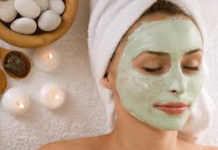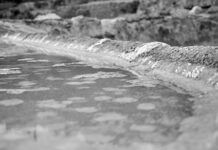f you follow a consistent skin care routine for your skin type (including facial cleanser, moisturizer, and eye cream), you likely already know that exfoliating should play a role in caring for your complexion. In case you need a refresher, exfoliation is the process of sloughing off dead skin cells from the surface of your skin. But it turns out there are actually two types of exfoliation: mechanical and chemical. What’s the difference? Well, that’s what we’re here to explain. Keep reading to learn about the differences between chemical exfoliation and mechanical exfoliation, as well as our best chemical exfoliants and best mechanical exfoliants to add to your skin care regimen.
WHAT IS CHEMICAL EXFOLIATION?
Chemical exfoliation involves the use of enzymes, beta hydroxy acids (BHAs) such as salicylic acid, or alpha hydroxy acids (AHAs) such as glycolic acid to dissolve dead skin cell buildup from the surface of your skin—no scrubbing necessary.
Chemical Exfoliation Option #1: BHAs. Like we mentioned above, BHAs like salicylic acid can be used for chemical exfoliation. The Cleveland Clinic states that salicylic acid removes dead skin and can improve the texture and color of sun-damaged skin.
Chemical Exfoliation Option #2: AHAs. Another option for chemical exfoliation is to use AHAs. The Cleveland Clinic explains that these include glycolic, lactic, tartaric, and citric acids. According to the Food & Drug Administration (FDA), products formulated with AHAs are marketing as having multiple uses, including smoothing fine lines and surface wrinkles, unblocking pores, and improving the condition of skin in general. The FDA notes that the extent of the effectiveness of these products will depend on the concentration of the AHA(s), the pH, and the other ingredients in the formula.
Keep in mind that AHAs like glycolic acid can leave your skin sensitive to the sun, so if you end up going with this option, make sure to apply a broad-spectrum sunscreen with an SPF of 30 or higher as directed in the morning. Take other sun protection measures as well, including limiting your amount of time in the sun (especially during the sun’s peak hours of 10 a.m. to 2 p.m.), seeking shade, and covering up exposed areas in long sleeves, pants, a broad-brimmed hat, and UV-blocking sunglasses.
Chemical Exfoliation Option #3: Enzymes. BHAs and AHAs tend to get all the attention, but enzymes are another option for chemical exfoliation. According to the Cleveland Clinic, like other chemical exfoliants, enzymes can be used to improve skin tone and texture. Per a study from the National Institutes of Health, enzymes may exfoliate skin and improve clarity with less irritation than acid treatments.
WHAT IS MECHANICAL EXFOLIATION?
Now onto the second type of exfoliation! Mechanical exfoliation calls for the use of a tool or product that will act to physically remove dead skin cells from your skin’s surface.
Mechanical Exfoliation Option #1: Body brush. Like we mentioned above, a physical instrument can be used for mechanical exfoliation. If you’re looking to exfoliate your body, one option is dry brushing. Want to learn more? Read our article, What is Dry Brushing? Learn Why Dry Brushes are Worth a Try.
Mechanical Exfoliation Option #2: Facial exfoliating brush. Another type of brush for exfoliation is a tool specifically for your face. These can be electric or not, but they’re intended to be used on damp skin with a cleanser. They’re great for getting that squeaky-clean feeling!
Mechanical Exfoliation Option #2. Scrub. You can also use a face or body scrub as your method of mechanical exfoliation. We recommend using a sugar scrub; they tend to be extra gentle as the granules will melt into your skin. Simply apply the scrub to your skin, massage it in circular motions, then rinse.
Mechanical Exfoliation Option #3: Washcloth or exfoliating towel. While washcloths are typically intended for simply getting clean, they can also be used to exfoliate. There are even some specifically meant for exfoliation. Exfoliating towels are also a thing, and typically provide more intense exfoliation—but keep it in mind that those aren’t meant for the face.









![Effect of sea mud compresses from Messolonghi lagoon as a treatment for cellulite [Experimental study]](https://saltandmud.gr/wp-content/uploads/2021/08/unnamed-218x150.png)










